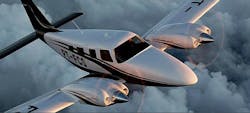Piper Aircraft offers three-display Garmin G1000 avionics on newest versions of Seneca V six-seat twin-engine aircraft
VERO BEACH, Fla., 10 March 2013.General aviation aircraft manufacturer Piper Aircraft Inc. in Vero Beach, Fla., is one of the first aviation companies to adopt the Garmin G1000 software supporting a three-display avionics suite as standard equipment in the Piper Seneca V six-seat twin-engine aircraft that will be available this year, Piper officials announced.
The G1000 from Garmin International Inc. in Olathe, Kan., is an all-glass avionics suite designed for situational awareness, simplicity, and safety to the cockpit, Piper officials say.
The latest Garmin G1000 software on the Seneca V includes Baro-VNAV approach for LNAV/VNAV vertical guidance whenever SBAS is not available or not approved; Vertical Profile View; user-defined holding patterns to enable the pilot to specify holding patterns manually; and the GSR 56-Iridium satellite communications transceiver.
The G1000 displays worldwide weather that informs pilots of METARs, TAFsm and winds aloft around the globe, with an optional GSR 56 transceiver. Radar and satellite imagery also are available in the U.S., Southern Canada, Western Europe, and Australia.
The G1000 also can support voice and data services to enable the pilot to worldwide phone calls, send text messages, and send email via SMS from the airplane’s cockpit using the GTN as the dialing and messaging interface.
The G1000 flight deck presents flight instrumentation, navigation, weather, terrain, traffic and engine data on large-format, high-resolution displays. It replaces the dual Garmin G600 suite currently on Seneca V’s.
Garmin’s GRS77 attitude and heading reference system (AHRS) provides digital output and referencing of aircraft position, rate, vector, and acceleration data.
The three display G1000-equipped Seneca V includes two 10-inch primary flight displays; one 10-inch multifunction display; two GIA63W NAV/COM/GPS; S-TEC 55X autopilot with altitude preselect; attitude and heading reference system; air data computer; two IFR enroute/approach and WAAS certified GPS; electronic engine indication system; Garmin FliteCharts; SafeTaxi; GMA1347 audio panel; GTX 33 Mode S transponder; traffic information systems (TIS); and Aspen standby system (EFD-100).
“The Garmin G1000 avionics suite is now on all of our M-Class and Twin-Class aircraft," says Jackie Carlon, Piper's director of marketing and communications. "The G1000 with three-displays standard in the Seneca V now gives pilots abundant flight-critical data that provides exceptional situational awareness and that will contribute to safer flying.”
The Seneca V has a maximum cruising speed of 197 knots; can fly as far as 826 nautical miles on a tank of gas; carries a standard useful load of 1,376 pounds; has six seats; and can fly as high as 25,000 feet. The plan is 28.6 feet long, 9.9 feet high, and has a wingspan of 38.9 feet.
For more information contact Piper Aircraft online at www.piper.com, or Garmin Avionics at www.garmin.com.
About the Author
John Keller
Editor-in-Chief
John Keller is the Editor-in-Chief, Military & Aerospace Electronics Magazine--provides extensive coverage and analysis of enabling electronics and optoelectronic technologies in military, space and commercial aviation applications. John has been a member of the Military & Aerospace Electronics staff since 1989 and chief editor since 1995.

